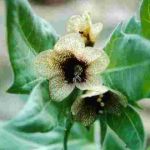| Taking henbane with these drugs may increase some of the effects of the drug: |
| Acetaminophen, Chlorpheniramine and Pseudoephedrine, (Children's Tylenol Plus Cold, Sinutab Sinus Allergy Maximum Strength) |
Acetaminophen, Dextromethorphan and Pseudoephedrine, (Alka-Seltzer Plus Flu Liqui-Gels, Sudafed Severe Cold) |
Acrivastine and Pseudoephedrine, (Semprex-D) |
Amantadine, (Endantadine, Symmetrel) |
Amitriptyline, (Elavil, Levate) |
Amitriptyline and Chlordiazepoxide, (Limbitrol) |
Amitriptyline and Perphenazine, (Etrafon, Triavil) |
Azatadine, (Optimine) |
Azatadine and Pseudoephedrine, (Rynatan Tablet, Trinalin) |
| Azelastine, (Astelin, Optivar) |
Brompheniramine and Pseudoephedrine, (Children's Dimetapp Elixir Cold & Allergy, Lodrane) |
Carbinoxamine, (Histex CT, Histex PD) |
Carbinoxamine and Pseudoephedrine, (Rondec Drops, Sildec) |
Cabinoxamine, Pseudoephedrine and Dextromethorphan, (Rondec-DM Drops, Tussafed) |
Cetirizine, (Reactine, Zyrtec) |
Chlorpheniramine and Acetaminophen, (Coricidin HBP Cold and Flu) |
Chlorpheniramine and Phenylephrine, (Histatab Plus, Rynatan) |
Chlorpheniramine, Ephedrine, Phenylephrine, and Carbetapentane, (Rynatuss, Tynatuss Pediatric) |
| Chlorpheniramine, Phenylephrine and Dextromethorphan, (Alka-Seltzer Plus Cold and Cough) |
Chlorpheniramine, Phenylephrine and Methscopolamine, (AH-Chew, Extendryl) |
Chlorpheniramine, Phenylephrine, and Phenyltoloxamine, (Comhist, Nalex-A) |
Chlorpheniramine, Phenylephrine, Codeine, and Potassium Iodide, (Pediacof) |
Chlorpheniramine, Pseudoephedrine, and Codeine, (Dihistine DH, Ryna-C) |
Chlorpheniramine, Pseudoephedrine, and Dextromethorphan, (Robitussin Pediatric Night Relief, Vicks Pediatric 44M) |
Chlorpromazine, (Largactil, Thorazine) |
Cimetidine, (Nu-Cimet, Tagamet) |
Clemastine, (Tavist Allergy) |
| Clomipramine, (Anafranil, Novo-Clopramine) |
Clozapine, (Clozeril, Gen-Clozapine) |
Cyproheptadine, (Periactin) |
Deptropine, (Deptropine FNA) |
Desipramine, (Alti-Desipramine, Norpramin) |
Desloratadine, (Aerius, Clarinex) |
Dexbrompheniramine and Pseudoephedrine, (Drixomed, Drixoral Cold & Allergy) |
Dexchlorpheniramine, (Polaramine) |
Dimethindene, (Fenistil) |
| Diphenhydramine, (Benadryl Allergy, Nytol) |
Diphenhydramine and Pseudoephedrine, (Benadryl Allergy/Decongestant, Benadryl Children's Allergy and Sinus) |
Doxepin, (Sinequan, Zonalon) |
Doxylamine and Pyridoxine, (Diclecti) |
Epinastine, (Elestat) |
Famotidine, (Apo-Famotidine, Pepcid) |
Fexofenadine, (Allegra) |
Fexofenadine and Pseudoephedrine, (Allegra-D) |
Fluphenazine, (Modecate, Prolixin) |
| Hydrocodone, Carbinoxamine, and Pseudoephedrine, (Histex HC, Tri-Vent HC) |
Hydroxyzine, (Atarax, Vistaril) |
Imipramine, (Apo-Imipramine, Tofranil) |
Ketotifen, (Novo-Ketotifen, Zaditor) |
Levocabastine, (Livostin) |
Lofepramine, (Feprapax, Gamanil) |
Loratidine, (Alaver, Claritin) |
Loratidine and Pseudoephedrine, (Claritin-D 12 Hour, Claritin-D 24 Hour) |
Mebhydrolin, (Bexidal, Incida) |
| Melitracen, (Dixeran) |
Mesoridazine, (Serentil) |
Mizolastine, (Elina, Mizolle) |
Nizatidine, (Axid, PMS-Nizatidine) |
Nortriptyline, (Aventyl HCl, Pamelor) |
Olopatadine, (Panatol) |
Oxatomide, (Cenacert, Tinset) |
Oxbutinin, (Ditropan, Oxytrol) |
Perphenazine, (Apo-Perphenazine, Trilafon) |
| Procainamide, (Procanbid, Pronestyl-SR) |
Prochlorperazine, (Compazine, Compro) |
Promethazine, (Phenergan) |
Promethazine and Codeine, (Phenergan with Codeine) |
Promethazine and Dextromethorphan, (Promatussin DM) |
Promethazine and Phenylephrine, (Promethazine and Phenylephrine) |
Promethazine, Phenylephrine, and Codeine, (Promethazine, Phenylephrine and Codeine) |
Protriptyline, (Vivactil) |
Quinidine, (Novo-Quinidin, Quinaglute Dura-Tabs) |
| Ranitidine, (Alti-Ranitidine, Zantac) |
Thiethylperazine, (Torecan) |
Thioridazine, (Mellaril) |
Thiothixene, (Navane) |
Trifluoperazine, (Novo-Trifluzine, Stelazine) |
Trimipramine, (Apo-Trimip, Surmontil) |
Tripelennamine, (PBZ, PBZ-SR) |
Triprolidine and Pseudoephedrine, (Actifed Cold and Allergy, Silafed) |
Tripolidine, Pseudoephedrine, and Codeine, (CoActifed, Covan) |

